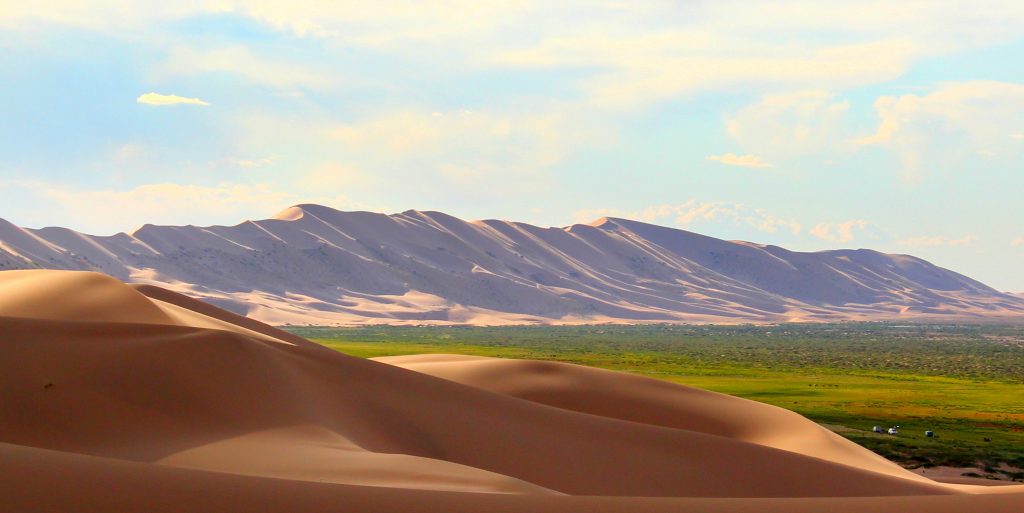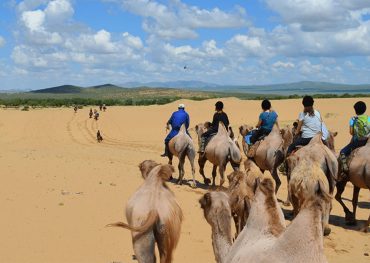From the northern Taiga to the Gobi Desert, passing through the vast valleys surrounded by the Khangai Mountains, experience the enriched adventure by meetings with the herders in their nomad settlements, on top of cultural and historical visits. It’s a rare opportunity to explore the long-line of nomadic country in the 21st century.
You will feel closer to nature when you spend nights in tents, nomadic yurts and a few in furnished yurt camps …
<p>As you arrive at the Chinggis Khaan international airport in Ulaanbaatar, the capital city of Mongolia, your guide-interpreter and driver will welcome you at the airport and lead you on to the city tour. The capital has plenty to offer. On the tour you will visit the Gandan Monastery, a historical and spiritual Buddhist temple in the city. Then you can walk around the National History Museum and the Chinggis Khaan Square in front of the Mongolian Parliament house to help you get a general knowledge and information about the Mongolian history and culture.</p><p>FB, Night in “White House” tourist hotel</p>
<p>After breakfast at the hotel, with your trip team you will depart to the southern region to reach the Baga Gazriin Chuluu, massive granite formations in the middle of the dusty plains. Attention, the road is not all asphalt and is full of potholes. Still, at your destination the view is beautiful: an undulating landscape with horses, cows, sheep and goats grazing in the vast landscape, occasionally herded by a horseman with a lasso on a long stick in his hand. Upon your arrival you can set up your tents on the granite formations. </p><p>Walk in the frame to visit the ruins of the monastery, destroyed in the years of massive purges, and a small spring revered by the local people.</p><p>FB, Overnight in tent</p>
<p>The tour continues and you descend further south by 4 × 4 to the Tsagaan Suvraga (White Stupa) located in Ulziit Soum, Dund-Gobi province. The name is given by local people to the impressive and legendary cliff which has been eroded by nature. Having 10 million years of history, the cliff indicates different eras through its colored layers. Tsagaan Suvraga is interesting to see, with its sheer slope facing east, which from a distance seem like ruins from an ancient city.</p><p>FB, Overnight in tent</p>
<p>On this day, your team will reach the Gurvan Saikhan National Park. The park hosts more than 200 bird species and you can find more than 600 different plant species. There are gazelles, gerbils and even snow leopards. After visiting the small museum of Yoliin Am (“Vultures valley” in Mongolian), you can take a nice stroll through the valley which ends by a chasm. If you are lucky you can see one of the massive vultures who habit there, which also gives their name to the valley.</p><p>On foot or on horseback, you move into the groove formed by the riverbed, and might be surprised to find a small hidden glacier believed to be eternal.</p><p>FB, Overnight in tent</p>
<p>Continuing the trip, you arrive at the national park of Khongor with its spectacular sand dunes like Duut Mankhan, meaning the singing dune. The dunes extending up to the foot of the high Altai Mountains range, lie about 180 kilometers from Dalanzadgad. It is at a distance of 130 kilometers along the desert tracks to Bogd in Uvurkhangai in the north, and 215 kilometers to Bayanlig on the northwest in Bayan Khongor. Travel through the desert is either by camel rides or by cars with drivers who are knowledgeable about the desert.</p><p>FB, Overnight in “Gobi discovery-2” yurt camp</p>
<p>This day will be spent in the area, climbing and walking the dunes. Some are up to 200 meters high. The dunes cover an area of approximately 20 kilometers wide and more than 100 kilometers long! It is intense to climb to the tops of the sand dunes and with much effort, you can overcome the sandhills. In the end, the reward is the incredibly beautiful view of the whole desert.</p><p>If you want, you can choose to have a tour riding a camel. * </p><p>*OPTIONAL</p><p>FB, Overnight in tent</p>
<p>After breakfast, with your team you will depart to Bayanzag, also called the Flaming Cliffs (Flaming Rocks). The rocky landscape gives a glowing orange color, like its name suggests. This is the region, in the Gobi Desert, where dinosaur fossils have been found. American paleontologist Roy Chapman Andrews gave this region its name after he visited it and found dinosaur eggs in 1920. These eggs not only established that all the dinosaurs were oviparous, but also inspired a certain Steven Spielberg for Jurassic Park. Other discoveries have also been made in the area such as the remains of a velociraptor.</p><p>FB, Overnight in tent</p>
<p>Leaving the Gobi Desert after breakfast,you will be continuing your journey in direction of the ruins of Ongi monastery.In the last century, Ongii Khiid was one of the largest monasteries in Mongolia, but It was destroyed in 1939 during the Stalinist purge of religious and cultural heritages. Its peculiarity is that it separates into two parts, on one side and on the other of the banks of the Ongi river. You arrive at the ruins early in the afternoon and can spend the day exploring the ruins of Ongi, some petroglyphs in the rocky masses, its small museum and the landscape around.</p><p>FB, Overnight in “Secret of Ongi” yurt camp</p>
<p>Today, your team will drive towards the Orkhon Valley, which was inscribed by UNESCO as a World Heritage (one of a few in Mongolia) as representing evolution of nomadic pastoral traditions and includes numerous archaeological remains dating back to the 6th century. The beauty of the natural site consists not only of green plains and hills bursting with basalt lines extending on both sides of the Orkhon River, but also of deer steles, hirgesuur (tombs in cairn), tombs with slabs, anthropomorphic and zoomorphic statues, ruins of ancient capitals.</p><p></p><p>At the end of the day, you will arrive at the “URSA MAJOR” geolodge camp, located on the valley. At night, when the sky is clear, you can stargaze by MEADE LX-200, the most powerful telescope in Mongolia. You can observe the stars, planets and galaxies from the steppes of the Orkhon Valley...</p><p>PC, Cozy night under a yurt in "URSA MAJOR" geolodge</p>
<p>On this day, you will be hiking and visiting the Tuvkhun monastery, which is the mountains, far from people and cities.</p><p>After breakfast, with your team you will take off in the direction of Shireet Mountain. Arriving at the parking area, you can start hiking through the conifer forest to reach the monastery located at 2.300 metres high. The temple was built in 1654 to serve as a refuge for Zanabazar, the 1st Bogdo Gegeen (spiritual and political leader) of Mongolia. A refuge where, in the hectic 17th century, he drew his strength to govern the country and preserve it from Manchu; but also, a refuge where he drew his inspiration as a religious leader and lavish artist. It was in this monastery that Zanabazar created the Soyombo alphabet, which later became a national symbol of Mongolia, and has been on the national flag since 1921.</p><p>FB, Overnight with a nomadic family</p>
<p>After breakfast with the family, take off to the Orkhon waterfall. Located in the heart of the valley, it is one of the best sights in central Mongolia. The waterfall was formed by a unique combination of volcano eruptions and earthquakes. The fall is naturally most impressive after heavy rain, but getting there allows you to pace around the beautiful area. At about fifteen meters high, it offers a nice walk along the banks of the river and, after a difficult descent, at the bottom of canyon! </p><p>FB, Overnight with a nomadic family</p>
<p>Early in the morning, you will depart and start the tour of Karakorum, the ancient capital of the Mongol Empire during the time of Chinggis Khaan (1162-1227). The current city of Karakorum is above all the seat of the best-known monastery in Mongolian territory: Erdene Zuu. Erdene Zuu means’ hundred treasures. The building dates from 1586 and once consisted of more than a hundred temples. Sadly, the complex has been subjected to many political ups and downs, at last being actively restored since 1990 around twenty remain today. The complex is fully fenced and every fifteen meters there are stupas, 108 in total, in the walls.</p><p>Continuing after the city, you travel by car to Khogno Khan nature reserve. The Khogno Khan mountains, considered sacred since the time of the Turks, presents very beautiful massive stone formations.</p><p>FB, Overnight in “Khoyor Zagal” yurt camp</p>
<p>After breakfast, the drive to the Khustai Mountains starts. You will be heading to the natural reserve of Khustai National Park, known for its famous Przewalski horses, called Takhi in Mongolian. These small “prehistoric” horses have been featured in cave paintings that go back more than 15 000 years and can be found in the Lascaux caves! These horses disappeared naturally in the 1960s, but were reintroduced to Mongolia through zoos from different countries. Since the arrival of twenty wild horses in 1992, the population has increased to about 300!</p><p>Upon your arrival at the natural reserve you can visit the National Park information center and get more history about the area. </p><p>In the afternoon, you will be able to observe the wild horses as they descend from the mountains. There are many other species of protected animals in the park: the red deer, Siberian roe deer, wild boars, Mongolian gazelle, gray wolf, Pallas's cat, Eurasian lynx and many more.</p><p>FB, Overnight in “Khustai” yurt camp</p>
<p>After breakfast you return to the capital Ulaanbaatar and arrive at your hotel. Take this time to have a little rest, then you’ll go shopping in the State Department Store, the largest shopping mall in Mongolia, a leftover of the Soviet occupation. There, you can find cashmere, leather, and whatever you want for souvenirs, presents and gifts. </p><p>In the evening you’ll indulge in Mongolian culture with a folklore show, concert of traditional music and contortion. You’ll hear performances with the Traditional Mongolian instrument Morin Khuur, a two-string fiddle adorned with a carved horse’s head; overtone singing, previously only used by shamans to enter into communication with the spirits.</p><p>At last, a farewell dinner with your team to wrap up an excellent journey full of memories.</p><p>FB, Night in “White House” tourist hotel</p>
<p>After having breakfast in the hotel, your team will drive you to the “Chinggis Khaan” international airport 2 hours before your departure.</p><p>Have a safe journey back!</p>
















